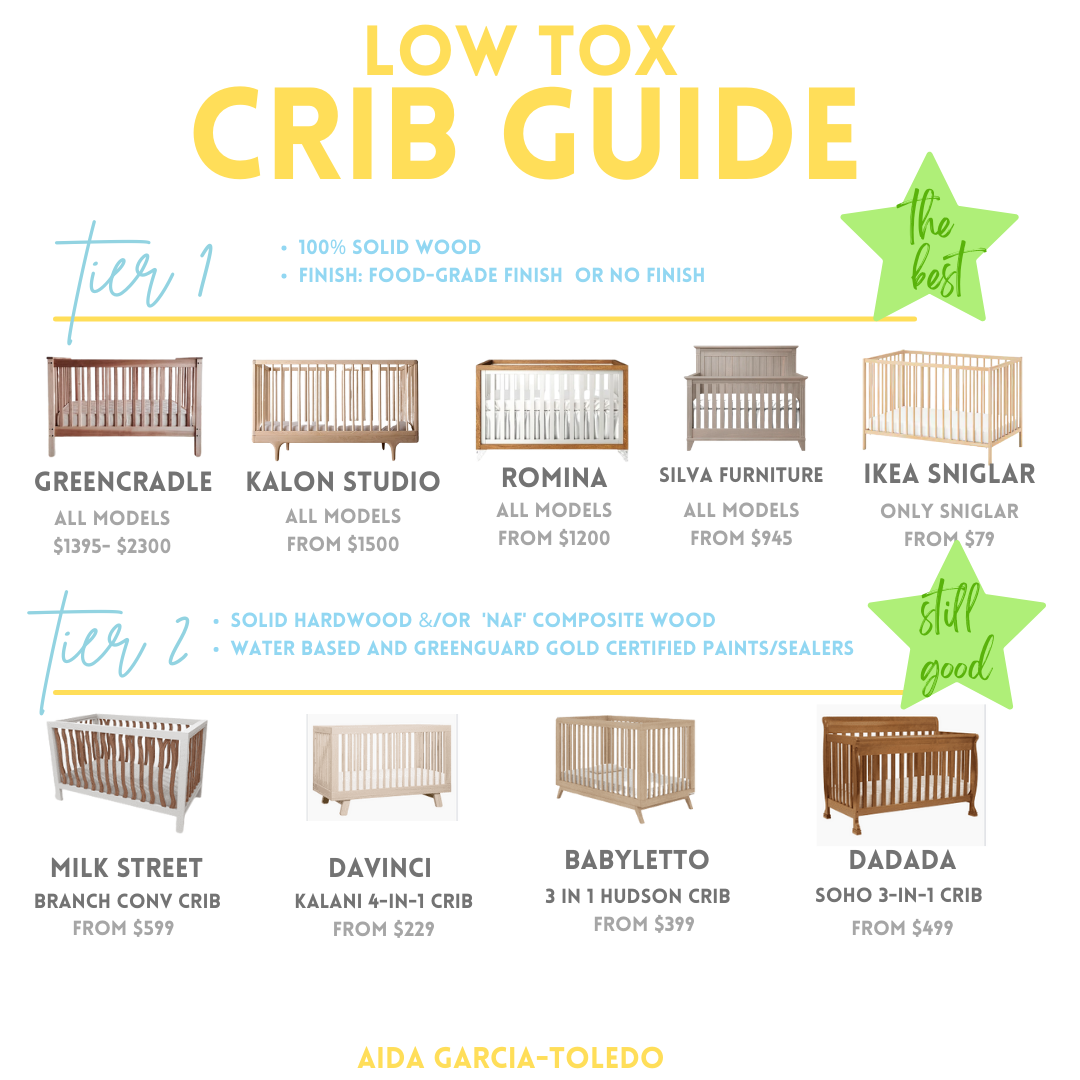Low-Tox Crib Guide
The nursery is the place where most babies spend many many hours. It makes sense that you want it to be as low tox of an environment as possible. But what does this mean?
Lets start with the heart of every nursery: the crib. I have an older post on choosing a non-toxic crib mattress which I believe is one of the most important investments for you baby. A close second? The actual crib
Again I have two tiers:
Tier 1: this is the ‘ideal crib’ - however be warned : very few exist and they can be quite pricey.
100% solid hardwood. (no composite wood (no MDF, plywood, etc.), laminates) or 100% soft woods like Pine, poplar, beech (these are lighter & less expensive than hardwood)
Finish: food-grade finish ( no paints or stains, that contain formaldehyde and other VOCs)
no glue or soy-based or water-based glue
Green cradle starting at $1395- $2300 (plus $300-$400 shipping)
All their crib models are made with 100% solid Oak, Brown Maple, Hard Maple, Walnut or Cherry hardwoods.
All finishes are hand rubbed onto the wood three times over many days
Finishes are 100% VOC free,
Kalon Studio Caravan Crib, from $1500
Made of 100% solid American maple hardwood
Wood is hand-rubbed with Kalon Bare Finish, a premium, organic plant-based oil/wax finish.
Crib converts as is to two different toddler bed styles:
100% solid hardwood,
organic glues
non-toxic, water-based, organic oil finishes
GreenGuard Gold Certified
most of which can be converted to a toddler bed, day bed, and full bed
100% solid Beechwood,
organic water-based or vegetable-based finishes only, and free of any volatile organic compounds (VOCs)
cribs are convertible into a toddler bed, day bed, and full size bed
sister brand to Romina (main difference is that these cribs are not Greenguard certified but materials would comply)
IKEA SNIGLAR from $79
100% unfinished beechwood (softwood)
because it is unfinished it has no harmful finishes nor stains.
can easily be converted into a toddler bed
Tier 2: These I consider good options too.
Combo of solid hardwood and/or composite wood BUT composite wood uses NAF (no added formaldehyde) adhesives
Paints or seals that are water based and Greenguard Gold certified
All glues are free from formaldehyde
This is not an exhaustive list
Milk Street Branch Convertible Crib (Natural) from $599
Made of Solid Grade A, New Zealand Pine / Acacia (100% solid wood)
Finished using only Greenguard Gold certified paints and stains.
Made of 100% New Zealand pine wood (softwood)
Greenguard Gold Certified
Made with pine wood
Greenguard Gold Certified paints
Made from solid beech wood
Greenguard Gold Certified (paint is polyurethane not water based but still has GreenguardGold certification)
What do I not recommend?
I do not recommend cribs made of traditional composite wood. By law they do meet TSCA Title VI standards for formaldehyde emissions (previously CARB2) which is the lowest emission standard in the world currently, however for a crib (or bed) I prefer zero formaldehyde than low formaldehyde.
What about non- wood cribs?
Metal: I generally stay away from all metal cribs. My concern is not toxicity (as most of them are steel and are tested for heavy metals like lead) but I do worry about metal increasing EMFs . However, to be fair there is not a lot of studies on this- so this a purely precautionary approach on my part. And, of course, if you are reducing EMFs in the bedroom (which we all should do anyway ) this would not be an issue. If you feel more comfortable with these - then these could be an alternative for you. I would make sure to ask about the paint/ finish on the metal : make sure it is not PVC based and does not come off. I would also ask to view heavy metal testing results to confirm no heavy metal in the metal used.
Acrylic: Again- I just don’t love the idea of a baby sleeping in a plastic bed. Older babies often do suck on the rails of their cribs and, while acrylic, is realtively stable as a plastic (meaning it does not easily leach out chemicals) there are some studies that have shown that all plastics contain some levels of estrogenic activity (ability to cause endocrine disruption)… under different situations. Again, purely precautionary I avoid at this stage in life.
Upholstery: Cradles and bassinets are sometimes upholstered. Here you want to make 100% sure that you avoid:
polyurethane foam: can give off VOCs
flame retardants: links to endocrine disruption and cancer
PFAS chemicals in stain/ water proofing fabrics
polyester based fabrics: often used as an alternative because it is somewhat flame resistant and water/stain resistant but can also contribute to micro plastic and potentially contain BPA- not ideal for a newborn sleep setting

